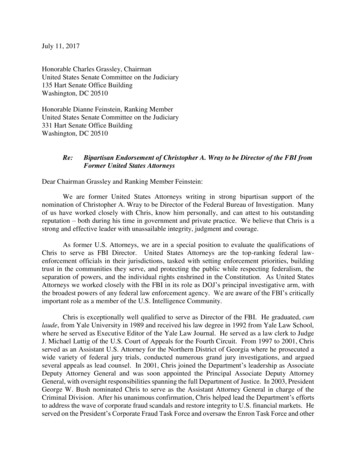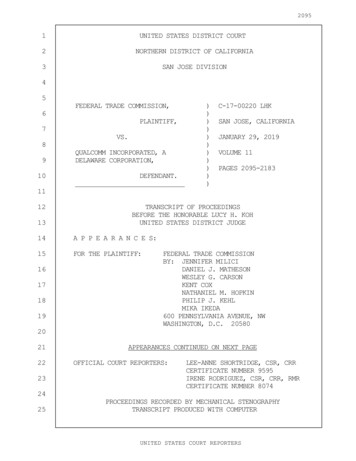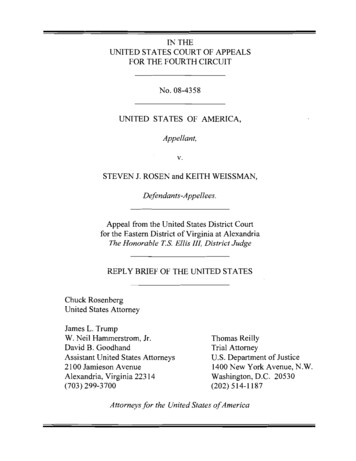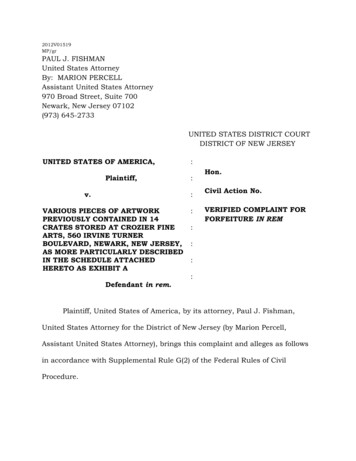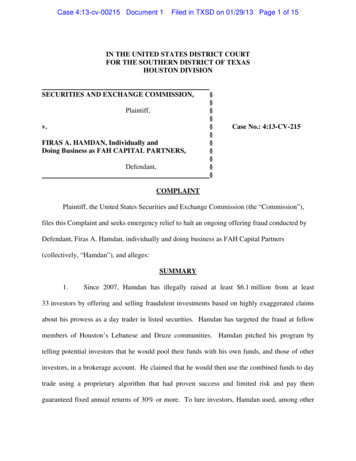
Transcription
Case 4:13-cv-00215 Document 1Filed in TXSD on 01/29/13 Page 1 of 15IN THE UNITED STATES DISTRICT COURTFOR THE SOUTHERN DISTRICT OF TEXASHOUSTON DIVISIONSECURITIES AND EXCHANGE COMMISSION,Plaintiff,v.FIRAS A. HAMDAN, Individually andDoing Business as FAH CAPITAL PARTNERS,Defendant,§§§§§§§§§§§Case No.: 4:13-CV-215COMPLAINTPlaintiff, the United States Securities and Exchange Commission (the “Commission”),files this Complaint and seeks emergency relief to halt an ongoing offering fraud conducted byDefendant, Firas A. Hamdan, individually and doing business as FAH Capital Partners(collectively, “Hamdan”), and alleges:SUMMARY1.Since 2007, Hamdan has illegally raised at least 6.1 million from at least33 investors by offering and selling fraudulent investments based on highly exaggerated claimsabout his prowess as a day trader in listed securities. Hamdan has targeted the fraud at fellowmembers of Houston’s Lebanese and Druze communities. Hamdan pitched his program bytelling potential investors that he would pool their funds with his own funds, and those of otherinvestors, in a brokerage account. He claimed that he would then use the combined funds to daytrade using a proprietary algorithm that had proven success and limited risk and pay themguaranteed fixed annual returns of 30% or more. To lure investors, Hamdan used, among other
Case 4:13-cv-00215 Document 1Filed in TXSD on 01/29/13 Page 2 of 15things, false brokerage documents allegedly demonstrating his past success. He also assuredpotential investors their principal was fully secured. However, the claims Hamdan made toentice investors and his promises of limited risk guaranteed returns were pure fiction.2.To support his claims of the past success and limited risk of his program, Hamdanmade several false claims to potential investors.For example: (a) he shared falsified TDAmeritrade, Inc. (“TD Ameritrade”) brokerage records that drastically overstated his tradinggains and assets under management; (b) he lied to investors about the existence and use of a socalled cash reserve account (“Cash Reserve Account”) that limited his at-risk capital; (c) hefalsely represented to potential investors that their investment was secured by a 5 million “keyman” insurance policy issued by Northwestern Mutual Life Insurance Co. (“NorthwesternMutual”); and (d) he falsely claimed that at least one well-known Dallas hedge-fund managerhad made a million-dollar investment in the MPP and had promised to invest more.3.Although Hamdan did day trade at least some of the investors’ funds in hisbrokerage account, he was anything but successful. Between 2007 and 2011, during most ofwhich time he continued to raise funds from investors, Hamdan lost almost 1.5 million throughtrading activity. His trading patterns show that he lost money consistently throughout theseyears and thus could not have generated sufficient returns to fund the monthly distributions hewas making to investors.4.Despite his tremendous losses, Hamdan continued to solicit new money frominvestors throughout 2012. Starting as early as 2009, however, some investors stopped receivingreturns and it appears Hamdan stopped paying any returns by October 2011. Throughout theremainder of 2011 and 2012, Hamdan continually provided various false excuses to investors forSEC v. Firas A. HamdanComplaintPage 2
Case 4:13-cv-00215 Document 1Filed in TXSD on 01/29/13 Page 3 of 15his failure to pay promised returns, even as he continued to solicit new funds. Hamdan receivednew funds from existing investors at least as recently as January 2012, and in December 2012,told investors he was expecting up to 700,000 in investments to start a new trading venture.5.By engaging in the conduct described in this Complaint, Hamdan has engaged ina fraudulent scheme and has made materially false and misleading statements, in connection withthe purchase of securities, and thus has violated and may be continuing to violate, the anti-fraudprovisions of the federal securities laws, including specifically Section 17(a) of the SecuritiesAct of 1933 (“Securities Act”) [15 U.S.C. § 77q(a)] and Section 10(b) of the Securities ExchangeAct of 1934 (“Exchange Act”) [15 U.S.C. § 78j(b)] and Rule 10b-5 [17 C.F.R. § 240.10b-5]thereunder.6.The Commission asks the Court to enter: ( 1) a temporary, preliminary, and permanentinjunction restraining and enjoining Hamdan; (2) an order directing Hamdan to disgorge all ill-gottengains, with prejudgment interest; and (3) an order directing Hamdan to pay civil penalties.JURISDICTION AND VENUE7.The investments offered and sold by Hamdan are “securities” under Section 2(1)of the Securities Act [15 U.S.C. § 77(b)1)] and Section 3(a)(10) of the Exchange Act [15 U.S.C.§ 78c(a)(10)].8.The Commission brings this action under the authority conferred upon it bySection 20(b) of the Securities Act [15 U.S.C. § 77t(b)] and Section 21(d) of the Exchange Act[15 U.S.C. § 78u(d)] to temporarily, preliminarily, and permanently enjoin Hamdan from futureviolations of the federal securities laws.SEC v. Firas A. HamdanComplaintPage 3
Case 4:13-cv-00215 Document 19.Filed in TXSD on 01/29/13 Page 4 of 15This Court has jurisdiction over this action under Section 22(a) of the SecuritiesAct of 1933 [15 U.S.C. § 77v(a)] and Section 27 of the Securities Exchange Act of 1934 [15U.S.C. §§ 78u(e) and 78aa].10.Hamdan has, directly or indirectly, made use of the mails and of the means andinstrumentalities of interstate commerce in connection with the acts, transactions, practices, andcourses of business described in this Complaint.11.Venue is proper in this district because certain of the acts, transactions, practices,and courses of business constituting the violations alleged in this Complaint occurred in theSouthern District of Texas and certain of the victims are located in this district.PARTIES12.Firas A. Hamdan, age 49, resides in Houston, Texas. His last known residence is1407 Meadow Rue Court, Sugar Land, Texas 77479. Hamdan does business under the name ofFAH Capital Partners, although FAH Capital Partners is not registered with the State of Texas asan entity or D/B/A.STATEMENT OF FACTSI.The Defendant13.Hamdan is well-known in the Houston-area Lebanese and Druze communities andhas enjoyed a reputation as a successful day trader. He is also a former treasurer of the Houstonbranch of the American Druze Society (“ADS”), a non-profit cultural organization to whichmany Houston-area members of the Druze religion belong.II.The Managed Private PortfolioSEC v. Firas A. HamdanComplaintPage 4
Case 4:13-cv-00215 Document 114.Filed in TXSD on 01/29/13 Page 5 of 15Beginning in approximately June 2007, Hamdan started operating a tradingvehicle with investors’ funds, which he describes as a managed private portfolio (“MPP”).According to Hamdan, the MPP eventually had a total of 33 investors, and as of December 2012,the MPP had 29 investors. Hamdan told the Commission staff that the MPP’s 33 investorsinvested a total of approximately 6.1 million with him, but as of December 2012, all investorfunds were depleted. Hamdan estimated that approximately 3 million of the 6.1 million totalfunds invested had been paid back to investors; 100,000 had been “loaned” to him for hispersonal living expenses; 1.5 million represented market losses; and the remaining 1.5 millioncould not be accounted for. The Commission staff has not been able to verify these statementsby Hamdan, but for purposes of this Complaint, assumes that he had at least 6.1 million undermanagement, raised money from at least 33 investors and that he cannot account for at least 1.5 million.15.Hamdan found investors for the MPP, among other ways, by talking with hisfriends and family, particularly those in the Houston Lebanese and/or Druze communities. Asword of his purported success began to spread, he began to solicit and accept investments fromfriends of friends and friends of family. He also encouraged existing investors to solicit theirfriends and family as new investors, and paid at least one investor a “finder’s fee” for identifyinga new investor. It is believed that most of Hamdan’s investors are of Lebanese descent and/ormembers of the Druze religion.16.Hamdan told investors that he had developed a proprietary trading algorithm totarget consistent returns while minimizing risk for the MPP investors. Hamdan explained toinvestors that his algorithm was “plugged into” his trading account at TD Ameritrade to furtherSEC v. Firas A. HamdanComplaintPage 5
Case 4:13-cv-00215 Document 1Filed in TXSD on 01/29/13 Page 6 of 15minimize investor loss. Hamdan promised investors that, as a result of this algorithm, he couldguarantee the fixed monthly return based on the amount they invested with him. Hamdan toldinvestors that he would keep all trading profits he made in excess of the agreed monthlydistribution and that he would also cover any losses below the agreed monthly distribution.17.Once investors agreed to make their investments, Hamdan and the investor wouldexecute “secured promissory notes” for the principal balance of each investment. Under thepromissory notes, Hamdan agreed to pay the investor a fixed monthly distribution for the life ofthe note, and agreed that the last monthly distribution payment would include the investors’principal amount. Although the precise terms of the notes appear to vary among investors, thenotes generally provide for returns of approximately 30% per year.In addition, in thepromissory notes, Hamdan expressly acknowledged that the investor’s money was for aninvestment in the MPP and that he was prohibited from using the investment proceeds to makethe monthly distributions to investors.18.After the promissory notes were executed, it was Hamdan’s general practice toinstruct investors to wire their principal investment to his personal bank accounts at either Bankof America or Chase Bank or his brokerage account at TD Ameritrade. It was then Hamdan’sgeneral practice to transfer most of the investor funds to his personal brokerage accounts at eitherTD Ameritrade or Interactive Brokers, LLC (“Interactive Brokers”). It appears Hamdan wouldconduct all of his trading activity under his own name, rather than FAH or the names ofindividual investors.19.Hamdan maintained and traded through his personal brokerage account atTD Ameritrade from 1996 until May 2011. According to Hamdan, TD Ameritrade closed hisSEC v. Firas A. HamdanComplaintPage 6
Case 4:13-cv-00215 Document 1Filed in TXSD on 01/29/13 Page 7 of 15account in May 2011 “because of monitoring activity.” At the time Hamdan left TD Ameritrade,his account had a balance of .02. After leaving TD Ameritrade, he opened an account withInteractive Brokers in June 2011 with a balance of 200,000, but according to Hamdan thataccount was later closed after he was asked to leave the brokerage firm. At the time Hamdan leftInteractive Brokers in November 2011, his account had negative 6.98 balance.20.Brokerage records maintained by TD Ameritrade for Hamdan’s account confirmthat he traded a significant volume of stocks in his 2007 to 2011, but also show that, contrary tohis claims, he was not a successful trader. Hamdan appears to have deposited about 4.5 millionof the 6.1 million total investor funds into his TD Ameritrade account, but as reflected in thechart below, he experienced a 1.4 million trading loss from 2007 to 2011:Year20072008200920102011III.Trading Gain/(Loss) (209,270.81) 293,842.62 (437,048.82) (437,431.16) (601,597.12)Total (1,391,505.29)Hamdan Entices Investors by Making Various False RepresentationsA.Hamdan Shows Investors Falsified Brokerage Account Statements21.To solicit investments in the MPP, Hamdan engaged in a series of fraudulentmisrepresentations. Hamdan would solicit potential investors by showing them documents thatpurported to be from his TD Ameritrade brokerage account. These documents reflected thatHamdan had a consistent history of significant profits and significant assets under investment.The actual TD Ameritrade records obtained by the Commission staff show that Hamdan wasunable to generate consistent positive returns, and routinely lost money.SEC v. Firas A. HamdanComplaintPage 7
Case 4:13-cv-00215 Document 122.Filed in TXSD on 01/29/13 Page 8 of 15A side-by-side comparison of Hamdan’s authentic TD Ameritrade records to therecords provided by Hamdan to investors show that Hamdan altered the authentic records beforeproviding them to investors. For example, Hamdan provided investors with a document that healleged was a statement received from TD Ameritrade for the first quarter of 2010. As reflectedin the document excerpts below, this document listed an opening cash balance of 2,327,970.76,quarterly trading gains of 2.7 million, and a closing cash balance of 5,148,210.02 for the firstquarter of 2010. The actual first quarter 2010 statement provided to the Commission staff by TDAmeritrade, however, shows an opening cash balance of 27,970.76, quarterly trading losses of (7,452.80), and a closing cash balance of only 148,210.02. Accordingly, it appears thatHamdan altered a copy of the actual statement, among other ways, by adding “2,3” to the front ofthe opening cash balance and a “5” to the front of the closing cash balance.Excerpt of fake first quarter 2010 TD Ameritradestatement provided to investors by Hamdan23.Excerpt of real first quarter 2010 TD Ameritradestatement for Hamdan’s accountSimilarly, Hamdan provided potential investors a purported TD Ameritradestatement for the second quarter of 2012 that listed an opening cash balance of 5,148,210.02,quarterly trading gains of 4.2 million, and a closing cash balance of 6,927,168.88 for thesecond quarter of 2010. The actual TD Ameritrade statement for the second quarter of 2010SEC v. Firas A. HamdanComplaintPage 8
Case 4:13-cv-00215 Document 1reflects significantly different figures.Filed in TXSD on 01/29/13 Page 9 of 15It shows an opening cash balance of 148,210.02,quarterly trading losses of (167,329.50), and a closing cash balance of only 53.71, almost 7 million less than the balance provided by Hamdan in the falsified statement.Excerpt of fake second quarter 2010 TD Ameritradestatement provided to investors by Hamdan24.Excerpt of real second quarter 2010 TDAmeritrade statement for Hamdan’s accountAs further proof of his trading success, Hamdan provided potential investors withhis purported TD Ameritrade Realized Capital Gain/Loss Reports from 2007 to 2010. Thesereports, which were on TD Ameritrade letterhead, purported to show that Mr. Hamdanexperienced trading profits of 3,964,810.79 in 2007, 5,718,079.31 in 2008, 7,412,012.51 in2009, and 14,119,486.45 in 2010. In reality, actual TD Ameritrade Realized Capital Gain/LossReports from 2007 to 2010 provide that Hamdan had trading profits of - 171,046.70 in 2007, 279,605.51 in 2008, - 430,004.86 in 2009, and - 475,155.53 in 2010. In other words, Hamdanappears to have exaggerated his trading prowess to potential investors by several million dollars.B.Hamdan Falsely Represents That He Maintains a Cash Reserve Account25.To further lure investors, starting in 2007, Hamdan represented to investors bothbefore and after they invested that he maintained a separate Cash Reserve Account in which heSEC v. Firas A. HamdanComplaintPage 9
Case 4:13-cv-00215 Document 1Filed in TXSD on 01/29/13 Page 10 of 15kept two-thirds of his available capital at all times. Hamdan would tell investors that, as a result,on a given trading day, he was trading with only one-third of his available capital, givinginvestors assurance that their capital would not be put at significant risk. However, there is noevidence of any Cash Reserve Account under either Hamdan’s or FAH’s names, and theCommission staff has concluded that, in all likelihood, such an account does not exist.C.Hamdan Falsely Represented That Investments Are Secured By anInsurance Policy26.Starting in 2007, Hamdan represented to potential, new and existing investors,and some of the promissory notes reviewed by the Commission’s staff provide, that investors’funds were secured with beneficiary rights in a 5 million key man insurance policy held byHamdan at Northwestern Mutual. However, Northwestern Mutual records show that althoughNorthwestern had entered into a life insurance contract with Hamdan, no beneficiaries werelisted in the contract and the policy was never issued.The contract was terminated byNorthwestern Mutual on February 21, 2011.D.Hamdan Falsely Represented That J. Kyle Bass Was an Investor27.Starting in at least 2010, Hamdan also enticed investors by representing to themthat he had received a 1 million investment from J. Kyle Bass, the founder and principal ofHayman Capital LP (“Hayman Capital”), a well-known Dallas-based hedge fund. Further,Hamdan told investors that Mr. Bass had agreed to place a second 1 million under investment ifHamdan continued to successfully generate the promised returns.Despite these claims,representatives of Mr. Bass have confirmed that that Mr. Bass has no knowledge of eitherHamdan or FAH and Mr. Bass never invested with Hamdan, either individually or throughHayman Capital.SEC v. Firas A. HamdanComplaintPage 10
Case 4:13-cv-00215 Document 1IV.Filed in TXSD on 01/29/13 Page 11 of 15Hamdan’s Scheme Begins To Unravel28.Based on his consistent trading losses and the Commission’s staff’s understandingof the returns Hamdan did pay to investors, Hamdan could not have paid investors from profitsgenerated through his trading activity or through the remaining investor principal balance.Instead, it appears that he used new investor funds to make the required monthly distributionpayments. It appears that Hamdan stopped paying some investors as early as 2009, and last paidany returns in the fall of 2011.29.After Hamdan stopped making all monthly distribution payments in the fall of2011, Hamdan began offering several excuses as to why he could no longer make the distributionpayments or access the purported Cash Reserve Account. Hamdan told investors that he held anaccount at the commodities brokerage firm MF Global that he used as collateral for a creditdefault swap on Greek sovereign debt that he had purchased through an account he held atGoldman Sachs. Hamdan told investors that after MF Global filed for bankruptcy in or aboutOctober 2011, Goldman Sachs asked him to re-collateralize the debt using his TD Ameritradetrading account as collateral and that, as a result, he was unable to remove the funds from his TDAmeritrade account. Further, on December 8, 2011, Hamdan sent an email to his investorsaddressing the lack of customer distributions, explaining that the MF Global bankruptcy hadfrozen his cash reserve account and that this was preventing him from making regulardistribution payments.All of these statements and excuses were a complete fiction.InDecember 2012, Hamdan informed the Commission’s staff that he has never held accounts withMF Global or Goldman Sachs. MF Global and Goldman Sachs have also confirmed that no suchaccounts exist.SEC v. Firas A. HamdanComplaintPage 11
Case 4:13-cv-00215 Document 130.Filed in TXSD on 01/29/13 Page 12 of 15In the summer of 2012, Hamdan represented to investors that he was being suedin federal court in Dallas, Texas by Kyle Bass of Hayman Capital and that his trading accountwas therefore “locked up,” preventing him from making monthly distribution payments toinvestors. However, there is no record of, and Hayman Capital has confirmed, that neither Mr.Bass nor Hayman Capital was ever involved in any lawsuit with Hamdan.V.Hamdan Has Continued to Solicit Investments31.Even after Hamdan stopped paying monthly returns in the fall of 2011, hecontinued to solicit new funds from existing investors in his promissory note scheme. In January2012, he received a 25,000 additional investment from an existing investor. Throughout 2012,Hamdan sent at least one investor text messages, discussing his solicitation of new investments.He also told another investor’s counsel that he was anticipating a new investment of 700,000from overseas investors, which he said he would use for a new trading program.32.On or about December 21, 2012, upon being contacted by the Commission staff,Hamdan promised in writing that he would stop soliciting any funds of any kind from existingand potential investors. However, in specific contradiction to his representations, Hamdanimmediately started soliciting new funds from current investors, purportedly to fund his legaldefense. Most recently, Hamdan has continued to lie to investors by telling them he is unable tomake monthly distribution payments because he is under investigation by the Commission.CLAIMSFIRST CLAIMViolations of Section 17(a) of the Securities Act33.The Commission repeats and incorporates paragraphs 1 through 32 of thisComplaint as if set forth verbatim.SEC v. Firas A. HamdanComplaintPage 12
Case 4:13-cv-00215 Document 134.Filed in TXSD on 01/29/13 Page 13 of 15Hamdan, directly or indirectly, singly, in concert with others, in the offer and saleof securities, by use of the means and instruments of transportation and communication ininterstate commerce and by use of the mails, has: (a) employed devices, schemes or artifices todefraud; (b) obtained money or property by means of untrue statements of material fact oromissions to state material facts necessary in order to make the statements made, in light of thecircumstances under which he were made, not misleading; and (c) engaged in transactions,practices or courses of business which operate or would operate as a fraud or deceit.35.recklessness.Hamdan engaged in the above-referenced conduct, knowingly or with severeHamdan was also negligent in his actions regarding the representations andomissions alleged herein.36.For these reasons, Hamdan violated, and unless restrained and enjoined, willcontinue to violate Section 17(a) of the Securities Act.SECOND CLAIMViolation of Section 10(b) of the Exchange Act and Rule 10b-537.The Commission repeats and incorporates paragraphs 1 through 32 of thisComplaint by reference.38.Hamdan, directly or indirectly, singly or in concert with others, in connectionwith the purchase and sale of securities, by use of the means and instrumentalities of interstatecommerce and by use of the mails have: (a) employed devices, schemes and artifices to defraud;(b) made untrue statements of material facts and omitted to state material facts necessary in orderto make the statements made, in light of the circumstances under which they were made, notmisleading; and (c) engaged in acts, practices and courses of business which operate as a fraudand deceit upon purchasers, prospective purchasers and other persons.SEC v. Firas A. HamdanComplaintPage 13
Case 4:13-cv-00215 Document 139.Filed in TXSD on 01/29/13 Page 14 of 15Hamdan engaged in the above-referenced conduct, intentionally, knowingly orwith severe recklessness regarding the truth.40.For these reasons, Hamdan violated and, unless restrained and enjoined, willcontinue to violate Section 10(b) of the Exchange Act and Rule 10b-5 thereunder.RELIEF REQUESTEDThe Commission seeks the following relief:1)An order of the Court that temporarily, preliminarily, and permanently restrainsand enjoins Hamdan, and, as appropriate, his agents, servants, employees, attorneys and allpersons in active concert or participation with him who receive actual notice of the injunction bypersonal service or otherwise, and each of them, from future violations of Section 17(a) of theSecurities Act, Section 10(b) the Exchange Act, and of Rule 10b-5 and from directly orindirectly soliciting or accepting funds from any person or entity for any unregistered offering ofsecurities.2)An order of the Court directing Hamdan to disgorge an amount equal to the fundsand benefits he obtained illegally as a result of the violations alleged, plus prejudgment intereston that amount.3)An order of the Court directing Hamdan to pay civil monetary penalties underSection 20(d) of the Securities Act [15 U.S.C. § 77t(d)] and Section 21(d) of the Exchange Act[15 U.S.C. § 78u(d)] for his violations of the federal securities laws.SEC v. Firas A. HamdanComplaintPage 14
Case 4:13-cv-00215 Document 14)Filed in TXSD on 01/29/13 Page 15 of 15Such further relief as this Court may deem just and proper.Dated: January 29, 2013Respectfully Submitted,s/ Bret HelmerBRET HELMERAttorney-in-ChargeTexas Bar No. 00793931S.D. Texas Bar No. 1505312TOBY M. GALLOWAYTexas Bar No. 00790733S.D. Texas Bar No. 18947United States Securities and ExchangeCommissionBurnett Plaza, Suite 1900801 Cherry Street, Unit 18Fort Worth, Texas 76102Telephone: (817) 978-6477 (Helmer)Fax: (817) 978-4927helmerb@sec.govOF COUNSEL:JONATHAN P. SCOTTD.C. Bar No. 456930MARK T. PITTMANTexas Bar No. 24013338TIMOTHY L. EVANSTexas Bar No. 24065211United States Securities and ExchangeCommissionBurnett Plaza, Suite 1900801 Cherry Street, Unit 18Fort Worth, Texas 76102ATTORNEYS FOR PLAINTIFFSEC v. Firas A. HamdanComplaintPage 15
account in May 2011 "because of monitoring activity." At the time Hamdan left TD Ameritrade, his account had a balance of .02. After leaving TD Ameritrade, he opened an account with Interactive Brokers in June 2011 with a balance of 200,000, but according to Hamdan that account was later closed after he was asked to leave the brokerage firm.





